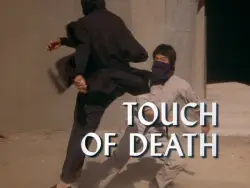Touch of Death (Quincy, M.E.)
| Touch of Death | ||||||||||||||||||||||||||||||||||||||
|---|---|---|---|---|---|---|---|---|---|---|---|---|---|---|---|---|---|---|---|---|---|---|---|---|---|---|---|---|---|---|---|---|---|---|---|---|---|---|

| ||||||||||||||||||||||||||||||||||||||
|
Episode Quote
"In science we must respect every tradition—but if a body speaks, we must listen. Always." ~ Dr. Quincy, in Touch of Death
Episode Overview
Touch of Death is the tenth episode of Quincy, M.E. Season 3, originally aired on NBC on December 2, 1977 . The episode centers on the sudden death of Sam Fujiyama’s cousin, martial artist Tad Kimura, and Quincy’s struggle between cultural sensitivity and uncovering the truth.
Application of The QME Episode Laws
Touch of Death exemplifies the **QME Episode Laws** through both plot and character development:
✅ **Law 1: A Quincy, M.E. story must always seek to uncover the truth and bring justice to the victim.** Despite family objections on cultural grounds, Quincy insists on a full autopsy once signs point to murder. His persistence leads to revealing the true cause of Tad’s death and pursuing justice.
✅ **Law 2: A Quincy, M.E. story must explore the social and ethical issues surrounding the case,** particularly the struggle for justice against powerful systems. The episode engages deeply with Sam’s Buddhist beliefs and community customs, showcasing Quincy’s respectful approach to navigating these complex issues for the sake of truth.
✅ **Law 3: A Quincy, M.E. story must never shy away from complex or controversial topics, but always approach them with sensitivity and respect.** The conflict between cultural tradition and medical necessity is treated with nuance. Quincy's respect for Sam’s position, even as he challenges it, highlights this sensitivity.
✅ **Law 4: A Quincy, M.E. story must strive for scientific accuracy in its medical and forensic investigations.** Quincy navigates forensic challenges—starting from external exam to full autopsy—while acknowledging the unusual “dim mak” theory. Scientific rigor remains central, even when the narrative entertains folklore.
Episode Synopsis
Tad Kimura, a rising martial arts film star and Sam’s cousin, suddenly collapses on set. Sam, honoring Buddhist tradition, initially halts the autopsy. Quincy negotiates a limited external exam, which proves inconclusive. Persisting, he obtains permission for a full autopsy and uncovers signs of a slow-acting internal injury—possibly caused by a secret martial-arts strike. Rumors point to "dim mak," a death touch technique. Quincy and Sam consult Master Tobi (Harold Sakata), who confirms the folklore. Quincy is later physically attacked in a rare ninja ambush. Ultimately, autopsy findings and forensic analysis disprove the myth; the cause is traced to a rare medical condition masked by the folklore. Sam returns to work, reaffirming their friendship and Quincy’s respect for cultural boundaries.
Plot Summary
Quincy investigates Tad Kimura’s death at Sam’s urging. Cultural tensions rise when Sam resigns over Quincy’s insistence on performing an autopsy. Through scientific inquiry, Quincy navigates Buddhism’s mortuary customs, confronts urban legends, and uses forensic pathology to dispel myth and reveal fact. The episode underscores Quincy’s dedication to both justice and cultural understanding.
← The Hero Syndrome • Touch of Death • The Deadly Connection Season 3 Overview: Full Episode List
Main Cast
- **Jack Klugman** as Dr. R. Quincy
- **Robert Ito** as Sam Fujiyama
- **Val Bisoglio** as Danny Tovo
- **John S. Ragin** as Dr. Asten
- **Garry Walberg** as Lt. Monahan
Guest Cast
- **Frank Michael Liu** as Tad Kimura
- **Keye Luke** as Otashi Hiyedo (Sam’s uncle)
- **Harold Sakata** as Master Tobi
- **Joanna Kerns** as Lily (Quincy’s temporary assistant)
- **Irene Yah-Ling Sun** as Mrs. Kimura
Case File Summary
Victim: Tad Kimura Case #: LACC 77.12.1023
Quincy investigates a sudden death initially assumed natural but reveals deliberate foul play masked by cultural beliefs. Tad’s death prompts examination of both physical and cultural truths.
Forensic Science Insight
- Highlights the conflict between cultural directives and medical necessity in forensic practice.
- Demonstrates stepwise forensic protocols: external exam → minimal imaging → full autopsy.
- Debunks “dim mak” via anatomical analysis—internal hemorrhage inconsistent with pressure-point tactics.
Themes & Tropes
- Cultural Ethics vs. Medical Duty
- Folklore vs. Forensic Truth
- Friendship under Strain
- Scientific Rigor Prevails
Reception & Ratings
- IMDb rating: 7.3/10 based on 1,011 user reviews
Critics acknowledge a compelling cultural-meets-forensic conflict at the heart of the episode.
Trivia
- Inspired by speculation around Bruce Lee’s death and martial arts mystique
- “Dim mak” debate and ninja-styled ambush add melodrama—but scientific resolution reinforces Quincy’s forensic integrity.
Cultural Impact
By embedding cultural tradition within a forensic murder mystery, “Touch of Death” expands *Quincy, M.E.*’s thematic reach—balancing respect for cultural practices with a hardline commitment to scientific truth. This mix of social sensitivity and procedural accuracy helped set early standards for later forensic dramas.
See Also
- Quincy, M.E.
- List of Quincy, M.E. episodes
- Forensic pathology
- Buddhism and medicine
- Martial arts folklore
External Links
- [IMDb entry for Touch of Death](https://www.imdb.com/title/tt0681870/)
- [Season 3 episode guide on TV Guide](https://www.tvguide.com/tvshows/quincy-me/episodes-season-3/1000032744/)
